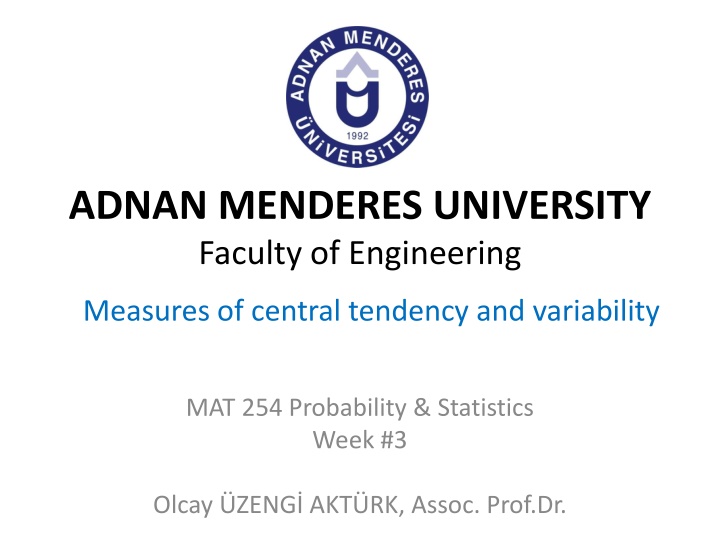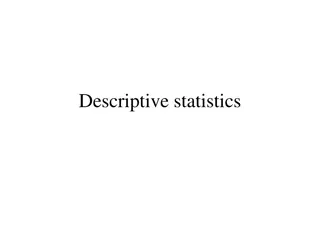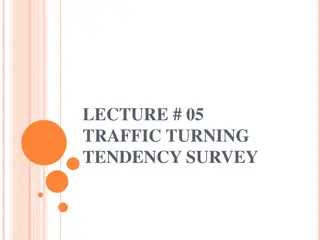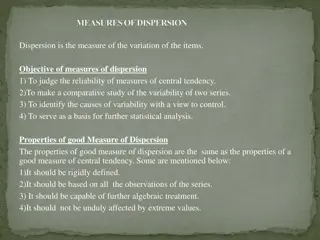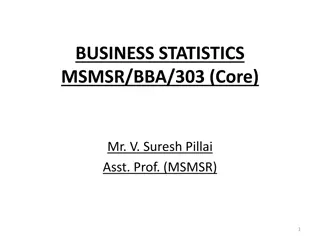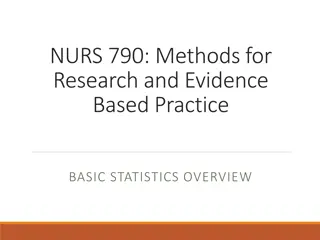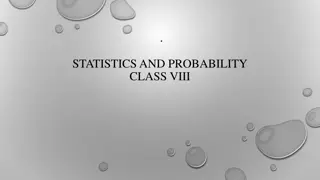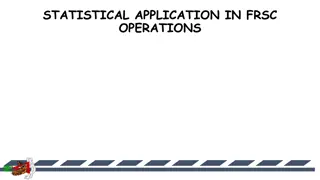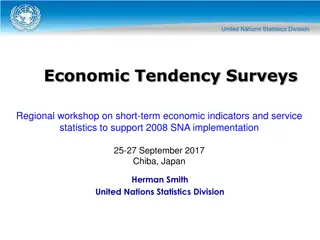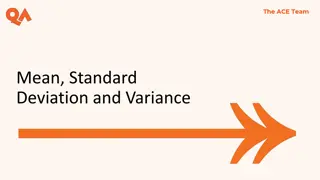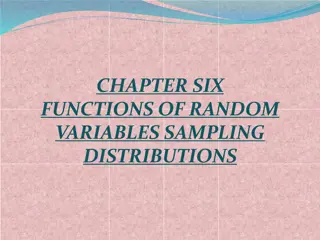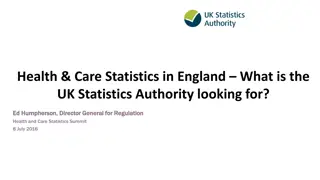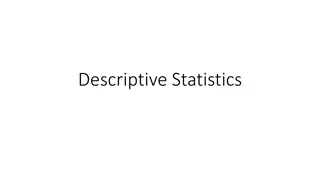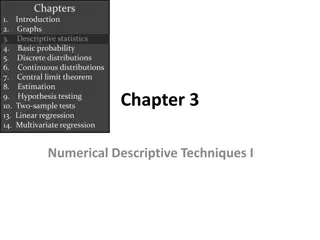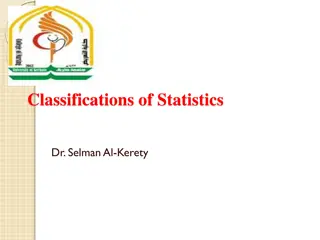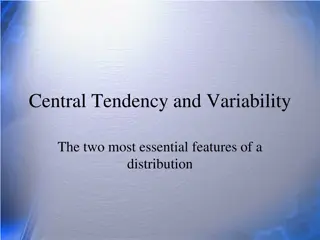Overview of Central Tendency Measures in Statistics
A measure of central tendency in statistics aims to describe a dataset by identifying its central position. This includes commonly used statistics like the mean. This article covers various aspects of central tendency measures, including data types, sampling techniques, graphical methods, and more.
Download Presentation

Please find below an Image/Link to download the presentation.
The content on the website is provided AS IS for your information and personal use only. It may not be sold, licensed, or shared on other websites without obtaining consent from the author.If you encounter any issues during the download, it is possible that the publisher has removed the file from their server.
You are allowed to download the files provided on this website for personal or commercial use, subject to the condition that they are used lawfully. All files are the property of their respective owners.
The content on the website is provided AS IS for your information and personal use only. It may not be sold, licensed, or shared on other websites without obtaining consent from the author.
E N D
Presentation Transcript
ADNAN MENDERES UNIVERSITY Faculty of Engineering Measures of central tendency and variability MAT 254 Probability & Statistics Week #3 Olcay ZENG AKT RK, Assoc. Prof.Dr.
Data Types Qualitative data (words) Blue, short Quantitative data (numbers) 1, 2.5, 10000 Discrete (countable) 1 car, 206 students Continuous (measurable) 165 cm, 52.5 kg Primary Ours Secondary Not ours 2
Sampling Techniques Probability Sampling (every member of the population has equal chance) Simple Random Sampling (Lottery) Systematic Sampling (every 4thsample) Stratified Sampling (from each area) Cluster or Area Sampling (form clusters) Multi-stage Sampling (multi-stage) Non-probability Sampling (samples are selected based on an inclusion rule) 3
Age Frequency Presentation of Data 12 2 13 13 14 27 15 4 Graphical Method Textual Method Tabular Method Rearrangement from lowest to highest Stem-and-leaf plot Frequency distribution table (FDT) Relative FDT Cumulative FDT Contingency Table Bar Chart Histogram Frequency Polygon Pie Chart Less than, greater than Ogive Percentage of causes of child death in Egypt accident 10% congenital 10% diarrhea 50% chest infection 30% Stem Leaves 1 7,8 2 0,3,3,4,5,6,7,8,9 3 4,4,5,5,7,8,8,8,8,9,9,9 4 2,3,4,4,5,6,6,8,9 5 0,0,0 4
Other Graphical Methods Box Plot (Box and Whisker) Lowest value Highest value Median Upper Quartile Lower Quartile Inter-Quartile Range Range Scatter Plot Correlation between Doppler velocimetry (RI) and baby birth weight 1 0.9 0.8 0.7 0.6 0.5 RI 0.4 0.3 0.2 0.1 0 1.5 2 2.5 3 3.5 4 4.5 baby weight in kg 5
How can you represent a huge amount of data (numbers) by using only one (or two) number(s)? Minimum of them? Maximum of them? Average of them? ???? CENTRAL TENDENCY 6
In statistics, a measure of CENTRAL TENDENCY is a single value that attempts to describe a set of data by identifying the central position within that set of data. As such, measures of central tendency are sometimes called measures of central location. The most commonly used statistics for measuring the center of a set of data, arranged in order of magnitude, are the mean, median, and mode. Mean (average) Median (middle) Mode (most) 7
? Sample Mean The mean (arithmetic mean or average) of a set of data is found by adding up all the items and then dividing by the sum of the number of items. x The mean of a sample is denoted by (read x bar ). 2 3 7 7 ? = 2+3+7+7/4 = 4.75 8
x Sample Mean Staff 1 2 3 4 5 6 7 8 9 10 Salary 1$ 1$ 1$ 1$ 2$ 2$ 2$ 2$ 100$ 100$ + + + + + + + + + 1 1 1 1 2 2 2 2 100 100 = x 10 = 21 2 . $ x 9
x Trimmed Mean (..) tr A trimmed mean is computed by trimming away a certain percent of both the largest and the smallest set of values. For example, the 10% trimmed mean is found by eliminating the largest 10% and smallest 10% and computing the average of the remaining values. + + + + + + + 1 1 1 2 2 2 2 100 = x 10 ( ) tr 8 = 11 1 . $ x 10 ( ) tr . 1 = 67 $ x ( 20 ) tr 10
x~ Sample Median 2 2 3 3 7 7 2 3 3 7 7 7 ? = 3+7/2 = 5 ? = 3 11
Sample Mode The most repeated value in observations 2 2 3 7 7 2 3 7 7 2 7 7 unimodal bimodal 12
Sample #1 : 1 51 101 151 201 ~ x = = 101 ; 101 x No mode ! Sample #2 : 99 100 101 102 103 ~ x = = 101 ; 101 x No mode ! Measures of spread or variability ???? 13
Sample Range The difference between the lowest and the highest value of that sample. 2 3 7 7 The range is 7-2 = 5 14
Variance & Standard Deviation 1 3 5 11 Variance s2= [(1-5)2+ (3-5)2+ (5-5)2+ (11-5)2] / (4-1) s2= [(-4)2+ (-2)2+ (0)2+ (6)2] / 3 s2= (16 + 4 + 0 + 36) / 3 s2= 56/3 = 18.666 ? = 1+3+5+11/4 = 5 Standard deviation ? = 18.666 = 4.32 16
Population vs. Sample Commonly used Symbols for a Sample and for a Population. 17
END of LECTURE #3 MAT254-02 Probability & Statistics 23
